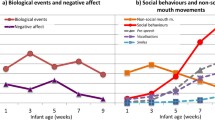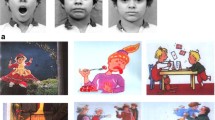Abstract
It was hypothesized the mothers' predictions of their caregiving interventions would be differentially influenced by infants' facial expressions of sadness, anger, and physical distress. Mothers viewed slides of infants whose facial displays had first been objectively classified with the Maximally Discriminative Facial Movement Coding System (Izard, 1979). Mothers imagined their infants showing similar expressions while scaling their own tendencies to respond with a number of specific caregiving and socializing interventions and affective reactions. Multivariate ANOVAs showed that the mothers' predictions differed for the three types of negative display. In an emotion decoding task, mothers' responses did not differ as a function of the infants' sex. The patterns of decoded emotions were most similar between physical distress and anger expressions, and least similar between physical distress and sadness expressions. Generally, the findings supported the hypothesis that the negative facial displayes signaled different affective states and had differential motivational effects on the mothers.
Similar content being viewed by others
References
Boucher, J. D. (1969). Facial displays of fear, sadness and pain.Perceptual and Motor Skills, 28 239–242.
Brash, J. C. (1948).Cunningham's manual of practical anatomy. Oxford: Oxford University Press.
Darwin, C. (1872).The expression of the emotions in man and animals. London: Murray.
Dollard, J., & Miller, N. (1950).Personality and psychotherapy. New York: McGraw-Hill.
Donovan, W. L., Leavitt, L. A., & Balling, J. D. (1978). Maternal physiological response to infant signals.Psychophysiology, 15(1), 68–74.
Ekman, P. (1973). Cross-cultural studies of facial expression. In P. Ekman (Ed.),Darwin and facial expression: A century of research in review. New York: Academic Press.
Ekman, P., & Eriesen, W. V. (1971). Constants across cultures in the face and emotion.Journal of Personality and Social Psychology, 17 124–129.
Emde, R. N., Kligman, D. H., Reich, J. H., & Wade, T. D. (1978). Emotional expression in infancy: I. Initial studies of social signaling and an emergent model. In M. Lewis & L. A Rosenblum (Eds.),The development of affect. New York: Plenum Press.
Finn, J. D. (1980).Multivariance. Univariate and multivariate analysis of variance, covariance, regression and repeated measures. Chicago: National Educational Resources.
Haviland, J. M. (1977). Sex-related pragmatics in infants' non-verbal communication.Journal of Communications, 27 80–84.
Hollingshead, A. B. (1975).Four-factor index of social status. Unpublished manuscript.
Izard, C. E. (1971).The face of emotion. New York: Appleton-Century-Crofts.
Izard, C. E. (1977).Human emotions. New York: Plenum Press.
Izard, C. E. (1978). On the development of emotions and emotion-cognition relationships in infancy. In M. Lewis & L. A. Rosenblum (Eds.),The development of affect. New York: Plenum Press.
Izard, C. E. (1979).The maximally discriminative facial movement coding system. Newark, Delaware: University of Delaware, Office of Instructional Technology.
Izard, C. E., Huebner, R. R., & Buechler, S. (1982).Mothers' perceptions of their infants' emotion expressions. Unpublished manuscript.
Izard, C. E., Huebner, R. R., Risser, D., McGinnes, G. C., & Dougherty, L. M. (1980). The young infant's ability to produce discrete emotion expressions.Developmental Psychology, 16 132–140.
Peiper, A. (1963).Cerebral function in infancy and childhood. New York: Consultants Bureau.
Tomkins, S. S. (1963).Affect, imagery, and consciousness. Vol. II. The negative affects. New York: Springer.
Wiesenfeld, A. R., & Klorman, R. (1978). The mother's psychophysiological reactions to contrasting affective expressions by her own and an unfamiliar infant.Developmental Psychology, 14(3), 294–304.
Will, J. A., Self, P. A., & Datan, N. (1976). Maternal behavior and perceived sex of infant.American Journal of Orthopsychiatry, 46(1), 135–139.
Author information
Authors and Affiliations
Additional information
This research was supported by National Science Foundation Grant No. BNS 78-04236. We are grateful to Elizabeth A. Hembree for coding the stimulus materials and for assistance in final revisions of the manuscript, and to Gail M. Schwartz for facilitating contacts with subjects.
Rights and permissions
About this article
Cite this article
Huebner, R.R., Izard, C.E. Mothers' responses to infants' facial expressions of sadness, anger, and physical distress. Motiv Emot 12, 185–196 (1988). https://doi.org/10.1007/BF00992173
Issue Date:
DOI: https://doi.org/10.1007/BF00992173




